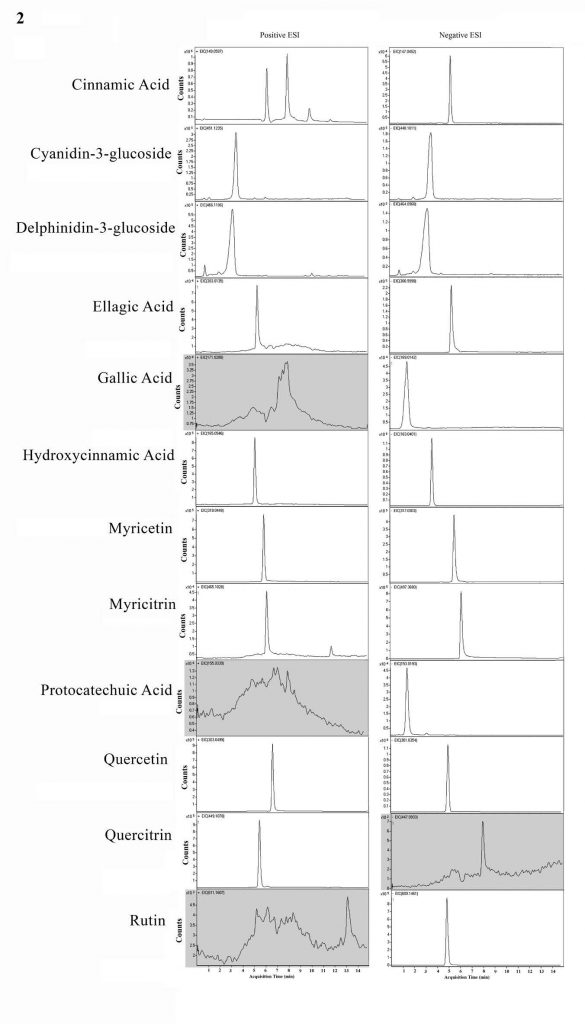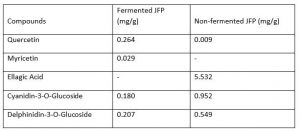Phenolic Compounds Separated with HPLC with LCMS
Click HERE for Column Ordering Information.
This simple Analytical Method was used to determine the content of very potent compounds present in Jaboticaba extracts and quantified some its Phenolic contents in fermented/non-fermented fruit; estimated by using standard addition.
It is important to know the quantitation of compounds before and after fermentation to optimize the valuable antioxidants for health benefits. This method is designed to evaluate the content of the extracts and primarily focuses on comparative analysis of content in fermented versus non-fermented Jaboticaba fruit powder (JFP) produced from the species Myrciaria jaboticaba (Vell.) Quantification of Cyanidin 3-O- glucoside is shown in the figure 1 and other compounds in figure 2.
 Figure 1:
Figure 1:
Overlaid extracted ion chromatograms of Cyanidin 3-O-glucoside in
(A) fermented JFP and spiked fermented JFP and
(B) non-fermented JFP and spiked non-fermented JFP.
Additional Phenolic Compounds: Quercetin, Quercitrin, Cinnamic Acid, Myricetin, Ellagic Acid, Gallic Acid, Hydroxycinnamic Acid, Protocatechuic Acid, Rutin and Delphinidin-3-glucoside were analyzed from Jaboticaba Fruit using HPLC ESI-TOF-MS; shown in Figure 2 below.
Compare to Cyanidin-3-glucoside in both Positive (left column) and Negative (right column) ESI .
 Figure 2:
Figure 2:
Extracted ion chromatograms of representative phenolic compounds evaluated in Jaboticaba fruit samples[1].
Method Conditions
Column: Cogent Phenyl Hydride™, 4μm, 100Å
Catalog No.: 69020-10P-2
Dimensions: 2.1 x 100mm
Mobile Phase:
—A: DI Water with 0.1% Formic Acid
—B: Acetonitrile with 0.1% Formic Acid
Gradient:
| Time (minutes) | %B |
| 0 | 5 |
| 1 | 10 |
| 12 | 90 |
| 14 | 90 |
| 16 | 5 |
Flow rate: 0.4mL / minute
Detection: ESI-POS/NEG Agilent Model 6210 MSD TOF Mass Spectrometer
SamplePreparation: Fruit of the cultivar Myrciaria jabotica.
Final concentration: 125mg / mL. Quantification of phenolic compounds by standard addition.

Notes: Jaboticaba (Myrciaria Jaboticaba) is a fruit native to Brazil that is popularly consumed as food or fermented beverages. The fruit is compared to grapes in the US and fresh fruit may begin to ferment 3-4 days after harvest. Alternate processes are used to extend shelf-life such as, jams, tarts wines and liquors.
[1] S. Watanabe, M. T Matyska-Pesek, J. De J Berrios, G. R Takeoka, J. J Pesek, “HPLC/ESI-TOFMS Identification and Quantification of Phenolic Compounds in Fermented/Non-Fermented Jaboticaba Fruit (Myrciaria jaboticaba (Vell.) O. Berg)”, Int. J. Food Sci, 3, (5) (2018) 105-109.
Attachment
A376 Comparison of Extracts in Jaboticaba Fruit Powder with LCMS pdf 0.7 Mb Download File


